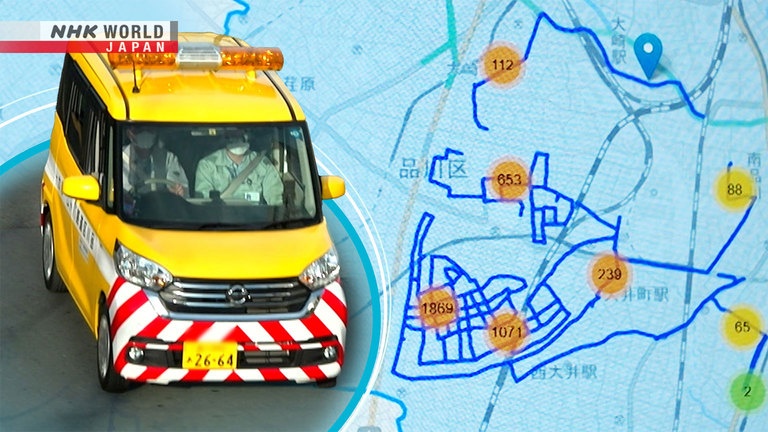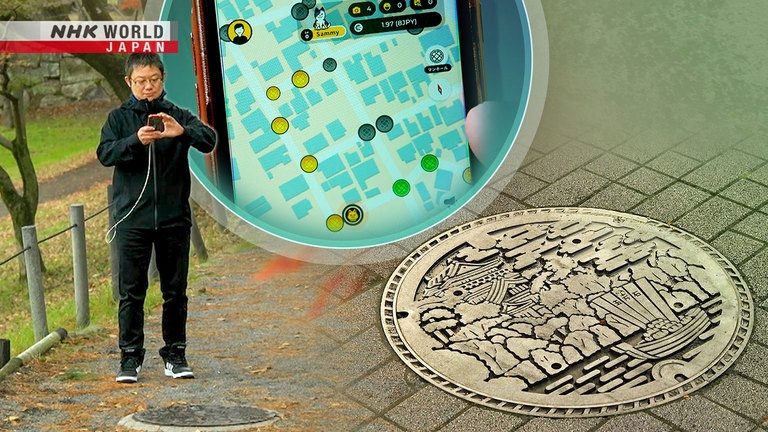Getting Smart with Road Repair
[SPECIAL EDITION]
This series includes selected stories from BIZ STREAM's signature "On-Site" reports. With a large portion of Japan's extensive infrastructure in use for nearly 60 years, experts must now constantly work to repair and maintain the nation's roads and highways. This report features companies that are using smartphones to identify and log damaged roads and manholes.
*Subtitles and transcripts are available for video segments when viewed on our website.
Getting Smart with Road Repair

A city road inspection vehicle uses a dash-mounted smartphone equipped with AI software to identify and report road damage, which is then sent to a cloud-based assessment and mapping system

The labor-intensive task of checking manhole conditions across Japan is now being turned into local events where members of the public help complete the task by using a game-like smartphone application
Transcript
Searching for road damage, while on the move.
And hundreds of volunteers happily hunting for...
manholes?
Both of these activities are using smartphones to inspect Japan's aging roads.
Today's On-Site Report shows how advances in technology
have made smartphones a key tool in keeping Japan's aging infrastructure safe and secure.
The only tool this road inspection vehicle is equipped with, as it patrols some of Tokyo's busiest streets,
is a single smartphone, mounted on the dash.
It's using a proprietary application called "Road Manager."
This software allows for detailed road inspections to be done without stopping.
The green boxes you see on the screen highlight areas where road damage has been found.
When the smart phone's AI-driven software detects cracks in the road,
it sends an image, along with other information, to a cloud-based data management system.
Even while in motion, the AI is able to detect cracks and fissures, as small as 5 millimeters in width.
The system can also detect fading or damage to white or yellow lines and other road markings.
Until now, road inspections were usually carried out in one of two ways.
The first method involved relying on the trained eyes of an inspection team.
However, because they need to stop to examine and log any damage manually,
this method can only cover about 15 kilometers of road per day.
The other method, using a specialized inspection vehicle, though highly accurate, is extremely expensive.
With usage fees costing over $75,000 per multi-day inspection, the city of Shinagawa would only agree to using it once every five years.
The "Road Manager" system, however, can be used in almost any vehicle,
and includes hardware, software, and analytic services for an annual fee of around $7,500.
Not only is it accurate and budget friendly, because the vehicle doesn't have to stop,
the system can inspect up to 40 kilometers of road per day.
Maeda Hiroya's company developed the "Road Manager" system.
While in university, he focused his studies on infrastructure inspection software.
With over a million kilometers of road, there's no way we can keep track of it the old-fashioned way.
Including his time in university, Maeda has collected over five million images of road damage, while working with local governments across Japan.
Using deep-learning to analyze the massive catalogue of images, he created a highly accurate damage recognition system.
The wave-form displays visual representation of road damage, while the numerical classification indicates the severity.
In addition, the system can take the images gathered by the front-facing smartphone camera,
and convert them into a bird's eye view image,
that allows them to accurately determine the size, scale, and orientation of any road damage detected.
After finishing an inspection route, team members head back to headquarters to go over the results.
The stretches of road, that were checked today, are shown with a thick blue line.
The number displayed indicates the total number of damaged sections detected.
Today's inspection resulted in the discovery and logging of 4,100 cases of road damage.
The system's AI, then classifies these cases into one of seven different types of damage;
such as "potholes," which can be hazardous to drivers, and "fatigue cracks," which can deteriorate further, leading to large-scale damage.
The AI system uses a scale ranging from 0 to 1, to indicate the level of damage discovered, with 1 being the most severe.
According to Shinagawa city regulations, potholes at or above 0.6,
and fatigue cracks at or above 0.7 in severity should be designated for repair.
Of the 4,100 instances of damage detected, nine reached or surpassed this threshold.
By clicking on a damage icon, the exact location is displayed, along with a still image of it, that was taken during inspection.
A team is then sent out to conduct a more detailed inspection of areas designated for repair.
In most instances the roadwork is completed within two weeks of initial detection.
Our predecessors built these roads for us one or two generations ago, so now it's our job to make sure we maintain them.
This man isn't lost, he's taking photos of manhole covers.
And he's not alone, a large group of people are combing the streets in search of them!
"Excuse me, what are you doing?"
This is a local event, where we take photos of as many manholes as we can.
Today's event is being held in Okazaki City.
Participants have been asked to take photos of manholes across a section of the city,
that runs approximately 10 kilometers north to south, and 4 kilometers east to west.
A specially-made "manhole hunting application" shows users locations that have to be checked.
In the area being covered today, 20,000 manholes have yet to be logged.
When a user uploads a photo to the app, its color changes to show it has been recorded.
With over 560 participants, event organizers hope that all 20,000 manholes can be photo-logged in just two days.
I'm on a diet, and trying to get out as much as I can.
It's fun to go around to different cities and regions, and see the various designs they have on their manhole covers.
I really want to come in first place, so I'm hoping to get over 1,000 photos.
Attracted by the fun, competitive style of the event, some participants came from as far away as Tokyo.
The top photo takers are ranked, and many participants are rewarded with gift certificates and other prizes.
The event was organized by Hayashi Satoru.
He works for a manhole manufacturer, and came up with idea of creating a smartphone game to help keep track of aging manholes.
There are so many them out there, there's no way we could check them all in a reasonable amount of time.
So I thought, maybe there's a way we could get members of the public to lend us a hand in getting the job done as quickly as possible.
In addition to the game, Hayashi is also working on developing an AI-based damage assessment program.
It can take a photo of any manhole, and instantly determine which of 21 different conditions apply to it.
Being able to handle the whole process on a single device really smooths everything out.
I also think it will help to increase our accuracy.
Hayashi hopes that by using this system, in conjunction with the manhole hunting events,
his company will be able to carry out necessary repairs faster than ever before.
Naturally, since we make manhole covers, we're always going to want to find and meet demand, wherever we can.
Back in Okazaki, the hunt is just coming to an end.
"How many did you get today?"
Let's see... in total, 832!
While I didn't quite reach my goal, I'm really happy that I could come down here and do something positive for this community.
In just two days, the participants succeeded in photographing all 20,000 manholes.
I think there are still quite a few manhole covers here that need replacing,
so these photos will help us to make sure that we can get the job done.